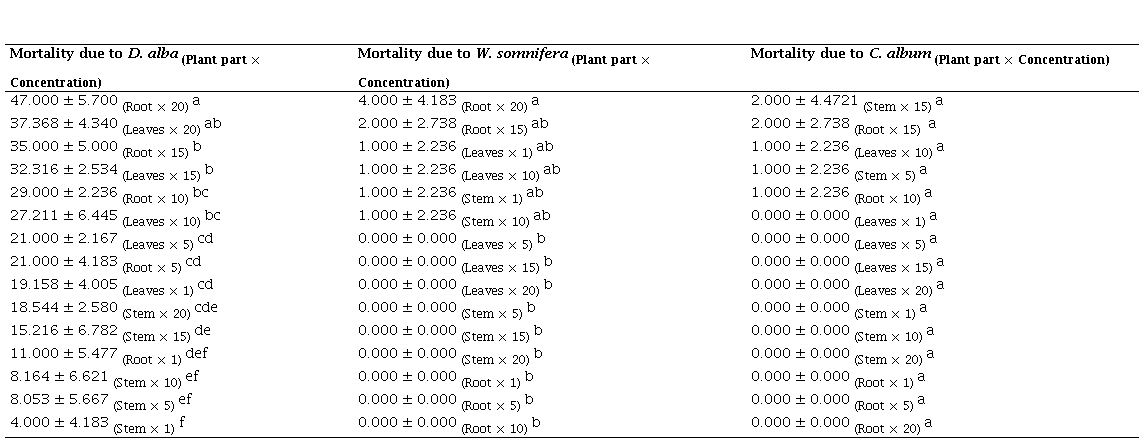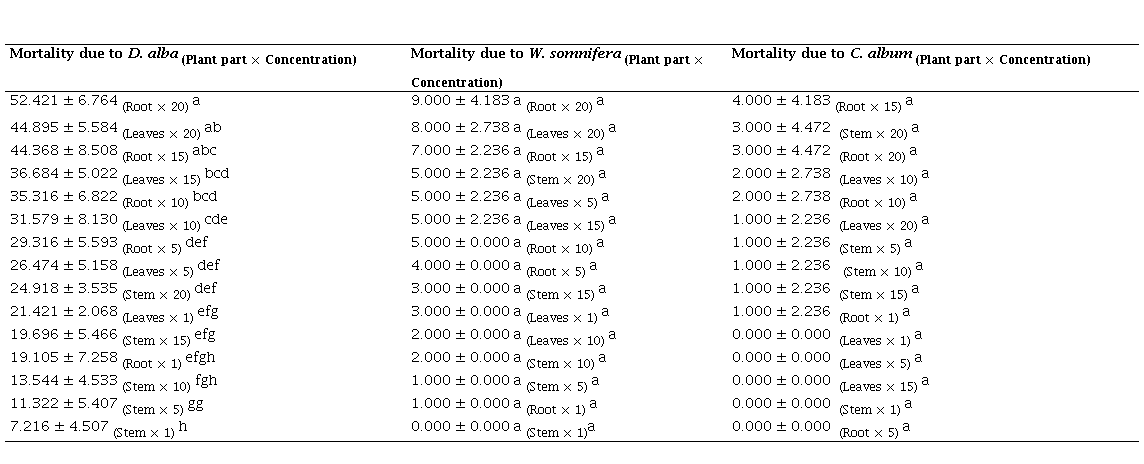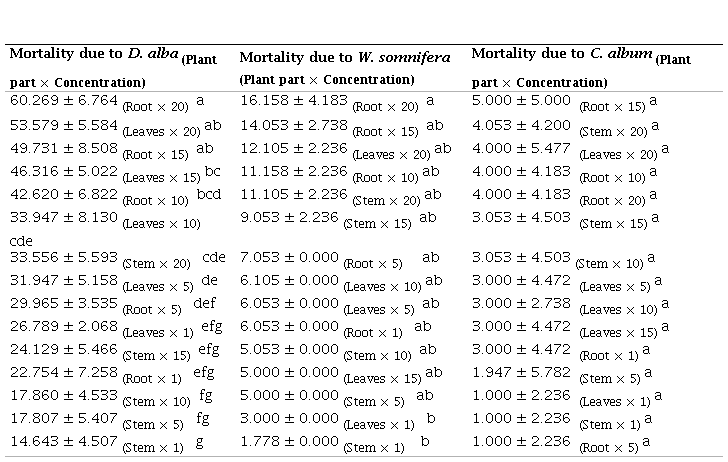Journal Information
Title: Enfoque UTE
Abbreviated Title: Enfoque UTE
ISSN (electronic): 1390-6542
Publisher: Universidad UTE (Quito, Ecuador)

Dusky cotton bug Oxycarenus hyalinipennis (Costa) (Hemiptera: Lygaeidae) causing both qualitative and quantitative damages to cotton crop from many years (USDA, 2009-2010) is major pest of cotton with many alternate host plants such as citrus, mango, avocado, dates, apple, fig, pomegranate, corn, peach, grapes, okra and pineapple. Cotton is the main cash crop of Pakistan and is major source of foreign exchange earnings. The cotton contribution in economy of the country is 1.6 per cent while its contribution in agriculture is 7.8 per centin terms of GDP (Farooq, 2012). It feeds generally on cotton seeds and reduces the viability by initiating damage to tissues causing 29.3 and 40.7 per cent damage to seed germination and cotton weight respectively when the population was 50 pairs per boll reducing the seed and oil contents to the tune of 42.9 and 36.1 per cent respectively (Srinivas and Patil, 2004).
Insecticides are most commonly being used for management of many insect pests. However these cause many problems such as environmental pollution which is a threat for the human health. Presently there is an increasing interest to evaluate the extracts of different plant species as an alternative source that might have insecticidal properties. These plants extracts may act like natural pesticides, fungicides, anti-feedants and repellent against different insect pests and are greatly safe for human beings and environment. Such plant species are recognized to have numerous bioactive compounds including alkaloids, steroids and flavonoids (Silva et al. 2005).
Several botanicals such as neem, rotenone, pyrethrum, essential oils, garlic, nicotine, ryania and sabadilla (Isman, 2005) are used as insecticides. There are various commercialization problems for these botanicals like shortage of natural sources, registration and their standardization (Isman, 1997). A number of plant species having insecticidal properties are at evaluation stages and will take some time to reach to the farmer. Many farmers in developing countries are applying them in crude form (Cloyd et al. 2009). The main advantages of botanicals is having low half-life, low human toxicity and can vanish from the environment in very short time (Shaalan et al., 2005). Further these can be applied at any stage of crop plants even just before harvesting or at harvesting stage without any risk of exposure to toxic chemicals by humans, insecticide residues in the harvest produce or human health effects during botanical use or preparation.
In the previous few years, weeds are being more and more explored for their phytochemical, pharmological and natural properties (Naqvi and Parveen, 1991; Ahmad et al., 2003a, b). Weeds are commonly classified as unwanted plants in the main crop and are regarded as crop pests; however, they have given away insecticidal properties as well against a lot of insects (Sagheer et al., 2013; Alkan et al., 2015; Vázquez-Covarrubias et al., 2015).
In Pakistan Bahawalpur region encompasses important flora and weeds for which insecticidal potential needs to be evaluated. Therefore in the current study, keeping in view the importance of this subject regarding insect pest management particularly for O. hyalinipennis, three weed plants namely D. alba, C. album and W. somnifera were targeted for the evaluation of their insecticidal efficacy against Oxycarenus under laboratory conditions.
The experiment was conducted during 2017 in completely randomized design (CRD) with five replications of each insecticide and a control treatment. Three weeds species were collected from the cholistan area of Bahawalpur, Punjab Pakistan. These were identified as Datura alba, Withania somnifera and Chenopodium album (Table 1) with their local names. Three different parts of weeds namely leaves, stems and roots were separated and washed for the preparation of extracts.

Hot water extraction method was used for each part of plant (leaves, stems and roots). Fresh weight (25 %) of the separately picked leaves, stems and roots (25gram) was mixed in 100 % distilled water (100 ml). The mixture was boiled at 100 .C then conditioned until it was cool (Barbosa et al., 2011). Afterwards five concentrations (1%, 5%, 10%, 15% and 20%) of each plant were prepared by dilution with distilled water and these were tested against O. hyalinipennis.
Dusky cotton bugs was collected from the field of cotton crop (Gossypium hirsutum) of the Islmia University of Bahawalpur. For insect bioassay adults and nymphs of collected insects were reared in transparent plastic cages under the conditions of 28 ± 2 .C, 65± 5% (R.H.) and a photoperiod of 14:8 h in laboratory (Khan et al., 2013). The mouth of plastic container was covered with muslin cloth. Fresh cotton bolls were provided on daily basis by replacing dried bolls (Srinivas and Patil, 2004). Cotton wicks were soaked in water and were provided to meet the moisture requirement (Ananthakrishnan et al., 1982). Egg laying was observed on lint and seeds. Freshly laid eggs are transparent light yellow in color oval and cigar shaped (Nayar et al., 1985). Eggs were collected and transferred to Petri dishes for hatching. To avoid the eggs desiccation, moistened blotting paper was provided in Petri dishes (Srinivas and Patil, 2004). Newly emerged nymphs were transferred to rearing medium to get the F1 generation. Cotton seeds soaked in water (Khan et al., 2013) and fresh cotton bolls with 10 % honey were provided as food (Srinivas and Patil, 2004).
Bioassay and Data Collection
Leaves of cotton (Gossypium hirsutum) were immersed for 1 minute in each concentration [1%, 5%, 10%, 15% and 20% and control (water only)] of each extract. These leaves were maintained in the shade and under free air for two h until excess water evaporated (Barbosa et al., 2011). After this, 20 O. hyalinipennis freshly emerged adults were released in Petri dishes to check mortality. The control treatment was treated with distilled water used in extraction process and dried similarly to the sample.
Data were recorded after 24, 48 and 72 h by visual inspection and per cent mortality was calculated by using formula Ec.1.
If mortality in treatments exceeded 5 %, it was corrected by using abbot’s formula (Abbot 1925) as per Ec. 2.
Where,
. = Corrected mortality (%)
X= Actual mortality (%)
Y= Control mortality (%)
Statistical analysis
Data were analyzed statistically by using Statistix software (Analytical software version 8.1). Analysis was done by factorial ANOVA separately for each weed for each time interval (24 h, 48 h and 72 h data) taking mortality data as dependent variable and independent variables were plant parts (leaves, stems and roots) and five concentrations. Interaction results of plant parts and concentration for each weed against each time period are reported as these summed up all important results. Mean were separated post hoc by Tukey HSD test at 5 % level of probability. A scatter plot diagram was obtained by putting together all mortality data from three weeds together to see the effect of weeds, concentrations, plant parts and time period on mortality of this pest.
After 24 h period, maximum mortality of O. hyalinipennis due to D. alba was (47.000 ± 5.700) due to interaction between root extract along with 20 % concentration while minimum mortality was recorded (4.000 ± 4.183) due to interaction between stem extract along with 1 % concentration (. < 0.05). For W. somnifera weed extracts, maximum mortality during 24 hours period was (4.000 ± 4.183) due to interaction between root extract along with 20 % concentration while minimum mortality was (0.000 ± 0.000) due to interaction between root extract along with 10 % concentration (. < 0.05). For C. album maximum mortality was (2.000 ± 4.4721) due to interaction between stem extract and 15% concentration while minimum mortality recorded was (0.000 ± 0.000) due to interaction between root extract along with 20 % concentration (. > 0.05) (Table 2).
Means in a column with different alphabets are significantly different P: 0.05.

After 48 h, maximum mortality due to D. alba extract was (52.421 ± 6.764) due to interaction between root extract and 20 % concentration while minimum mortality was (7.216 ± 4.507) due to interaction between stem extract and 1 % concentration (. < 0.05). Maximum mortality due to W. somnifera extract was (9.000 ± 4.183) due to interaction between root extract and 20 % concentration while minimum mortality was (0.000 ± 0.000) due to interaction between stem extract and 1 % concentration (. > 0.05). Maximum mortality due to C. album was (4.000 ± 4.183) due to interaction between root extract and 15 % concentration while minimum mortality was (0.000 ± 0.000) due to interaction between root extract and 1 % concentration (. > 0.05) (Table 3).
Means in a column followed by different alphabets are statistically different at P: 0.05.

Means in a column followed by different alphabets are statistically different at .: 0.05.
After 72 h, maximum mortality due to D. alba extract was (60.269 ± 6.764) due to interaction between root extract and 20 % concentration while minimum mortality was (14.643 ± 4.507) due to interaction between stem extract and 1 % concentration (. < 0.05). Maximum mortality due to W. Somnifera was (16.158 ± 4.183) due to interaction between root extract and 20 % concentration while minimum mortality was (1.778 ± 0.000) due to interaction between stem extract and 1 % concentration (. < 0.05). Maximum mortality due to C. album was recorded (5.000 ± 5.000) due to interaction between root extract and 15 % concentration while minimum mortality was recorded (1.000 ± 2.236) due to interaction between root extract and 5 % concentration (. > 0.05) (Table 4).
Means in a column followed by different alphabets are statistically different at P: 0.05.

Means in a column followed by different alphabets are statistically different at P: 0.05.
Botanicals like neem extracts have been recommended against O. hyalinipennis along with chemical insecticides (USDA 2021). Current study results can be compared with Abbas et al. (2015) which stated that greater concentrations of 2.5 and 5 % of some plant extracts led to more mortality of O. hyalinipennis compared with their less concentrations however they used different set of plants eg. Milkweed, tobacco, neem, citrus, castor and moringa.
A study (Sultana et al., 2016) conducted on efficacy of extracts of some medicinal plants against a stored grain pest Cryptolestes ferrugineus (Stephens) (Coleoptera: Cucujidae) indicated that mortality of pest insect increased with increasing oil extract concentration. These results suggest that weeds extracts can give increased mortality of Oxycarenus Spp. if the concentration of plant extracts is increased.
Comparison of results along three time periods shows that maximum mortality of O. hyalinipennis was generated after 72 h’ time periods and minimum and least mortality was after 24 h’ time periods. These results are in agreement with those of Sultana et al. (2016) that showed mortality of Trogoderma granarium (Everts) (Coleoptera: Dermestidae) treated with weed extract was significantly more after six days than after four or two days treatment time. However repellency of insects decreased as treatment period increased in their experiments. These results can also be compared with those of Saleem et al. (2014). Their results showed mortality of different storage pests insects increased by increasing extract concentrations and exposure time for different medicinal plant extracts including Dhatura extract.
Our results can be compared with other studies that showed the relative importance of different plant parts for difference in their toxicological effects. A study (Asiry, 2015) showed that stem aqueous extracts of bitter apple was revealed to be more effective than its root by 0.83 per cent, its leaf by 0.47 per cent and its fruit by 0.36% for managing Rhopalosiphum padi (L.) (Homoptera: Aphididae). Thus it becomes imperative to evaluate insecticidal potential of whole plant and all of its parts separately as well.
It has been stated that in a comparative studies of plant oils against pulse beetles, although other botanicals compared with neem resulted in significantly less mortality of pest species yet those had negative effect on other life history parameters for this pest species for example prevention of egg laying and reduced population buildup (Sharma et al. 2016).
Overall efficacy of weeds’ hot water extracts in terms of mortality of O. hyalinipennis
Overall efficacy is shown by scatter plot diagram (Fig 1). The diagram shows mortality is more in case of D. alba followed by W. somnifera and least due to C. album. Effect of concentrations shows minimum mortality due to 1 % extract and maximum is often due to highest concentration of 20%. Plant parts effect shows root extracts usually yielded the highest mortality followed by leaf extracts and minimum due to stem extracts. Effect of time period shows maximum mortality after 72 h and minimum after 24 h.
This study revealed that the weed species D. alba proved potent among the tested weeds against O. hyalinipennis resulting in maximum mortality. On the other hand, maximum mortality of 60 % limit under current conditions suggest to either increase the concentration of this weed e.g., D. alba against this pest to gain maximum mortality following this method or some other extraction method e.g. ethanolic extracts should be evaluated to gain greater mortality of this species.
Abbott, W. S. (1925). A method of computing the effectiveness of an insecticide. Journal of Economic Entomology, https://doi.org/10.1093/jee/18.2.265a .
Ahmad, B., Jan, Q., Bashir, S., Nisar, M., Shaheen, F., & Ahmad, M. (2003). Pharmacological and biological investigations of Chenopodium murale Linn. Asian Journal of Plant Sciences, https://doi.org/10.3923/ajps.2003.1107.1111 .
Ananthakrishnan, T. N., Raman, K., & Sanjayon, K. (1982). Comparative growth rate, fecundity and behavioural diversity of the dusky cotton bug, Oxycarenus hyalinipennis Costa (Hemiptera: Lygaeidae) on certain malvaceous host plants. Proceedings of the Indian National Science Academy, https://bit.ly/3CdPI7l .
Asiry, K. A. (2015). Aphidicidal activity of different aqueous extracts of bitter apple Citrullus colocynthis (L.) against the bird cherry-oat aphid, Rhopalosiphum padi (L.) (Homoptera: Aphididae) under laboratory conditions. Journal of Animal and Plant Sciences, http://www.thejaps.org.pk/docs/v-25-02/19.pdf .
Barbosa, F. S., Leite, G. L. D., Paulino, M. A. O., Guilherme, D. O., Souza, J., & Farnandes, R. C. (2011). Toxicity of extracts of Cyperus rotundus on Dibrotica speciose. Acta Scientiarum Agronomy,, https://bit.ly/3pZ4wBV .
Isman, M. (1997). Neem and other botanical insecticides: Barriers to commercialization. Phytoparastica, https://doi.org/10.1007/BF02981099 .
Isman, M. B. (2005). Botanical insecticides, deterrents and repellents in modern agriculture and an increasingly regulated world. Annual Review of Entomology, https://doi.org/10.1146/annurev.ento.51.110104.151146 .
Khan, M. A., Gogi, M. D., Bashir, M. H., & Hussain M., Abidin. (2013). Assessment of density dependent feeding damage by cotton dusky bug, Oxycarenus laetus Kirby (Hemiptera: Lygaeidae), in cotton. urkish Journal of Agriculture and Forestry, https://doi.org/10.3906/tar-1303-21 .
Saleem, S., Hassan, M., Sagheer, M., & Sahi, S. T. (2014). Insecticidal activity of essential oils of four medicinal plants against different stored grain insect pests. Pakistan Journal of Zoology, https://bit.ly/3IHZBMM .
Shaalan, E., Canyon, D., Younes, M., Abdel-Wahab, H., & Mansour, A. (2005). A review of botanical phytochemicals with mosquitocidal potential. Environment International, https://doi.org/10.1016/j.envint.2005.03.003 .
Sharma, R., Devi, R., Yadav, S., Sharma, R., Sharma, U., Kumar, A., & Godara, P. (2016). Effect of some botanicals against pulse beetle, Callosobruchus maculatus (F.) infesting pigeonpea. Legume Research, https://doi.org/10.18805/lr.v39i6.6647 .
Silva, T. M. S., Agra, M. F., & Bhattacharyya, J. (2005). Studies on the alkaloids of Solanum of northeastern Brazil. Revista Brasileira de Farmacognosia, https://doi.org/10.1590/S0102-695X2005000400005 .
Srinivas, M., & Patil, V. B. (2004). Biology of dusky cotton bug, Oxycarenus laetus Kirby (Hemiptera: Lygaeidae) on cotton. Karnataka Journal of Agriculture Sciences, https://bit.ly/3tt3I96 .
Sultana, K., Zahoor, M. K., Sagheer, M., Nasir, S., Zahoor, M. A., Jabeen, F., & Riaz, B. (2016). Insecticidal activity of weed plants, Euphorbia prostrata and Chenopodiastrum murale against stored grain insect pest Trogoderma granarium Everts, 1898 (Coleoptera: Dermestidae). Turkish Journal of Entomology.
Halbert, S., Dobbs, T, Cotton seed bug, Oxycarenus hyalinipennis (Costa): A serious pest of cotton that has become established in the Caribbean Basin, 1726, , https://bit.ly/3trY1rX, .
USDA, Technical Bulletin- Oxycarenus hyalinipennis osta) (Hemiptera: Oxycarenidae) Cotton seed bug, , https://bit.ly/3IOheur, .